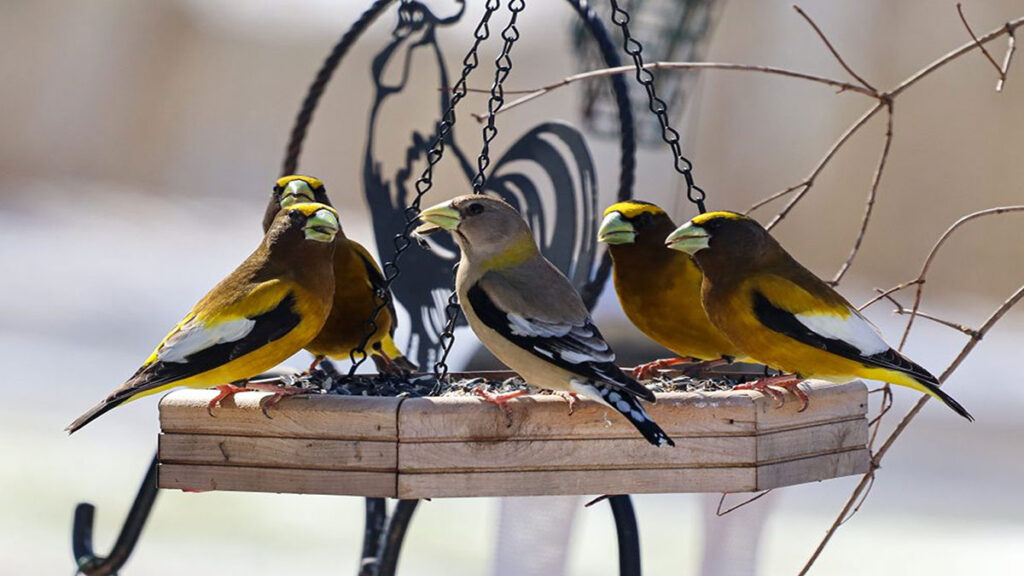Healthy Bird Feeding Practices
The below 4 steps will help reduce disease transmission

Feeder Disease Alert:
None noted at feeders at this time.
Since Fall of 2021, a highly pathogenic avian influenza (HPAI H5N1) has been detected in numerous outbreaks in North America. It is a naturally-occurring virus especially prevalent among wild aquatic birds such as ducks, geese and shorebirds and has been shown to affect commercial and backyard poultry with high mortality.
The Cornell Lab of Ornithology has created a webpage that collects current Avian Flu research and answers commonly asked questions about bird feeding and avian flu.
Wellness for Finches is Wellness for You!….If you practice following the below healthy bird feeding tips.
1.Regularly clean feeders
The most effective way to clean bird feeders is a combination of washing with dish soap and then soaking them in a 9:1 bleach solution (i.e., 9 qt water to 1 qt bleach) for fifteen minutes. This should be done at least monthly, and if you have extra feeders, rotate them out with dry food as you clean the other feeders. Or put up fewer feeders—only the amount you can regularly maintain—and spread them out to reduce the concentration of birds. Be sure to let the feeders dry out before restocking, and always remember to wash your hands as well.
2. Clean bird baths
Use same solution as above, and try to give fresh water daily.
3. Clean areas under feeders frequently
Keep the feeding area clean by regularly raking up shells and droppings from under feeders.
4. It’s best not to handle sick birds, let your local wildlife agency
know if you see sick birds.
Window Collisions are also a very important topic to keep in mind when feeding birds, and here is an article about Evening Grosbeaks and window collisions: https://www.fws.gov/story/dont-let-sun-set-evening-grosbeaks
For more information on window collisions here is more information from WildBirds Unlimited: https://www.wbu.com/window-strikes/
For additional best practices see below and this link here as well: https://www.wbfi.org/feedsmart/
As bird feeders, we’re more than just provisioning food; it’s our responsibility to ensure that we’re providing a clean, safe environment so these visitors are in tip-top shape when they’re ready to return to their breeding grounds. If we’re not careful, we may unknowingly be aiding the spread of deadly disease.
Scientists have long observed Salmonellosis—infections caused by Salmonella bacteria—in songbirds at feeders. Pine Siskins are especially susceptible to this infection, according to their Birds of the World account, but other birds like House Finches, American Goldfinches, and Evening Grosbeaks can also suffer from the disease. Infected birds show symptoms such as diarrhea, ruffled or fluffed-up feathers, lethargy, and overall weakness, followed by death, and outbreaks can kill thousands of birds in a winter.
Irruptions can put Pine Siskins at higher risk for the spread of these infections. Pine Siskins are generalists who will happily visit bird feeders in enormous flocks during irruption years when they run out of food in the core of their range. However, feeders can have their own dangers. Feeders concentrate birds of multiple different ]species into tighter and prolonged proximity. This increases the chance of disease spreading directly between birds or indirectly through fecal matter or contaminated surfaces. For example, genetic sequencing found that a 2009 Salmonella outbreak among Pine Siskins in the Eastern United States originated with an infected American Goldfinch, and the responsible strain’s distribution was densest where Pine Siskins were most concentrated. It can also affect Common Redpolls when they irrupt in large numbers.
Conjunctivitis is also well known for impacting House Finches, especially in the east, where they were introduced, but conjunctivitis can also affect American Goldfinches, Purple Finches and Evening Grosbeak and others..
Trichomoniasis has hit Purple Finches in the Maritimes and European Greenfinches in Eurasia at various times as well.
If we choose to offer food to these charismatic finches, it’s our job to prevent the spread of disease that feeding stations might exacerbate. If diseased birds are noted, we at the Finch Research Network strongly urge people to take down your feeders for a few weeks, allowing the birds to disperse and feed on wild food sources—especially if you see any suspected cases of Salmonellosis among your visiting birds. If you’d like to continue provisioning food, you should:
We’re grateful that when birds have visited us, now let’s thank them by taking care of them as well as we can.
The health benefits of watching nature and birds are endless, and more and more studies continue to be published about these benefits, and if there was one silver lining to COVID, it was how people found calm and peace engaging with nature whether by getting outdoors, or even by watching feeders or feedercams. Here’s a link listing several scientific studies about some of these benefits:
https://www.themindfulbirdingnetwork.com/scientific-studies
FiRN is a nonprofit, and has been granted 501c3 status. FiRN is committed to researching and protecting these birds and other threatened finch species like the Evening Grosbeak and Rosy-finches, and if you have been enjoying all the blogs and identifying of Red Crossbill call types, redpoll subspecies and green morph Pine Siskins FiRN has helped with, please think about supporting our efforts and making a small donation at the donate link below.
